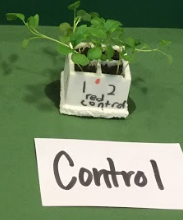Today in Science, we mixed colored sugar and liquids. The liquids we mixed with colored sugar were oil, vinegar, and water.
The way we made the colored sugar is we took 4 teaspoons of regular sugar, and then we squirted some purple food coloring onto it. After that, we mixed it until all of the sugar was purple.
The first liquid we mixed with colored sugar was oil. Our hypothesis for this was: If we put the colored sugar into the oil, then both materials will stay separated and the color will stay in the sugar. Our hypothesis was correct: They both stayed separated, and the color didn’t spread.
The second liquid we mixed with the colored sugar was water. Our hypothesis was: If we put the colored sugar into the water, then the color will spread and the sugar will dissolve. Our hypothesis was confirmed. The color spread and the sugar dissolved.
The last liquid we mixed with the colored water was vinegar. Our hypothesis was: If we put the colored sugar into the vinegar, then the sugar will dissolve and the color will spread. We were only half correct: the color spread, but the sugar did not dissolve.
Overall, I had a lot of fun doing this project and learned a lot. Thanks for reading!


 Stay tuned to hear more about our Rube Goldberg, and in the last post, I will include a video of our Rube Goldberg in action!
Stay tuned to hear more about our Rube Goldberg, and in the last post, I will include a video of our Rube Goldberg in action!
